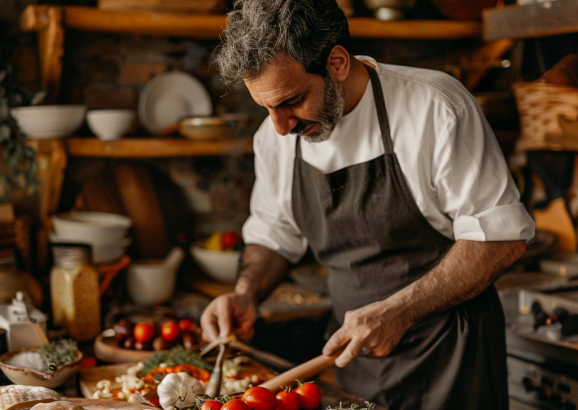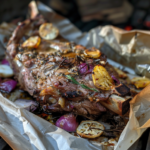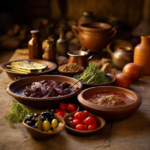Unlocking the Secrets of Traditional Greek Cooking: Techniques That Define Mediterranean Cuisine
Let’s take a culinary journey as we explore the time-honored practices that make traditional Greek cooking a testament to the Mediterranean lifestyle. Greek cuisine is an eloquent expression of the country’s rich history and the ingenuity of its people, refined over centuries. Here, we unveil the revered techniques that infuse each dish with the soul of Greek culture.
The Quintessential Art of Grilling: The Greek Way
Grilling is a fundamental method in Greek gastronomy, deeply rooted in the ethos of simplicity and purity. We celebrate the elemental flavors brought forth by cooking over an open flame.
Mastery of Meat Preparation
- Marination Mastery: Greek cuisine honors the natural flavors of meat. A traditional marinade often consists of olive oil, lemon juice, garlic, and herbs like oregano, rosemary, and thyme, tenderizing the meat and infusing it with robust flavors.
- Precision in Meat Selection: Select cuts of meat are crucial. Lamb, a Greek staple, is chosen for its rich, gamey taste that perfectly grills.
Charcoal Grilling Techniques
- Consistent Heat Management: We maintain a constant temperature, ensuring meat cooks evenly while retaining juiciness.
- Optimal Grill Times: Varying meats have specific grill times; for instance, Souvlaki, a beloved dish, requires attentive turning and just the right amount of time over the coals for that perfect char.
The Symphony of Slow Cooking: Stifado and Beyond
Slow cooking, or “kakavia,” captures the essence of Greek home cooking, allowing flavors to meld and ingredients to soften into mouthwatering stews and casseroles.
The Layering of Flavors
- Base Flavor Development: We start with the “trinity” of Greek cooking: onions, garlic, and tomatoes, sautéed to create a flavor foundation.
- Low and Slow Philosophy: Dishes like Stifado benefit from gentle simmering hours, intensifying the dish’s complexity.
The Craft of Casserole Cooking
- Aromatic Herb Infusion: The strategic use of bay leaves, cinnamon, and allspice in dishes such as Moussaka contributes depth and hints of Greek terroir.
- Baking to Perfection: Casseroles are baked slowly to achieve a gratifying texture contrast—crisp topping over a succulent base.
The Delicate Dance of Seafood Preparation
Seafood, a cornerstone of the Greek diet, demands respect and a delicate hand to preserve its freshness and delicate flavors.
Expertise in Freshness
- Sea-to-Table Selection: We advocate for daily-caught seafood to ensure peak freshness, a non-negotiable in Greek cooking.
- Minimalist Seasoning: Seafood is enhanced with a touch of lemon, olive oil, and occasionally ouzo, highlighting its natural taste.
Grilled to Perfection
- Grilled Octopus Precision: Octopus is tenderized and then grilled to a crisp exterior while maintaining a tender interior, a hallmark of Greek seafood preparation.
Celebrating Phyllo: The Art of Greek Pastry
Phyllo dough is the canvas for many Greek pastries, both savory and sweet, demanding skill and patience.
Mastery of Dough Manipulation
- Butter Brushing Technique: Each layer of phyllo is meticulously brushed with melted butter, ensuring flakiness and richness.
- Filling Consistency: Fillings, whether for Spanakopita or Baklava, are balanced in flavor and texture, complementing the delicate phyllo.

Embracing the Richness of Greek Cheese
Greek cheese, from Feta to Kasseri, plays a pivotal role, often as a cornerstone for many dishes.
Perfect Pairing Practices
- Balancing Saltiness: We counterbalance the innate saltiness of cheeses like Feta with the sweetness of fruits or the earthiness of vegetables.
- Grilling Techniques for Halloumi: Halloumi is grilled to achieve a crispy exterior while preserving its melt-in-your-mouth interior.
Integrating Olive Oil: The Liquid Gold of Greek Cooking
Olive oil is not just an ingredient but a sacred element in Greek cooking, revered for its health benefits and flavor.
The Role of Olive Oil in Cooking
- Cooking and Finishing: We use different grades of olive oil for cooking and finishing dishes, elevating their taste profiles.
- Salad Dressing Fundamentals: Olive oil forms the base of Greek salad dressings, emulsified with vinegar and citrus juices for a balanced vinaigrette.
Sourcing the Bounty of the Land: Vegetables and Legumes
Greek dishes are renowned for their incorporation of a wide array of fresh vegetables and legumes, offering a tapestry of textures and nutrients that underpin the health benefits of Mediterranean eating.
The Farm-to-Table Connection
- Locally Sourced Vegetables: We prioritize vegetables grown in the Greek soil, reaping the benefits of the Mediterranean climate to enhance natural flavors.
- Legume Integration: Legumes are a staple, simmered in olive oil and tomato-based sauces, absorbing aromatics and becoming hearty meal components.
Crafting Greek Salads
- The Perfect Greek Salad: A harmony of ripe tomatoes, crisp cucumbers, green bell peppers, and red onions, crowned with a slab of feta and a sprinkle of olives, dressed in our authentic olive oil dressing.
Fermentation and Preserving: Capturing the Greek Summer
Preservation techniques are a testament to Greek ingenuity, transforming seasonal bounties into year-round delicacies.
Olive Curing Mastery
- Traditional Brining Methods: We cure olives in brine, vinegar, or oil, each method imparting unique flavors, preserving the fruit’s integrity.
- Flavor Enhancements: Herbs and lemon zest often accompany the curing process, integrating complexity into the olives’ flavor profiles.
Preserved Vegetables and Fruits
- Sun-Dried Tomatoes: Tomatoes are halved and sun-dried, concentrating their sweetness and providing a chewy texture.
- Spoon Sweets Tradition: Fruit preserves, or ‘spoon sweets,’ are prepared using a slow-cook method that encapsulates the essence of the fruit.
The Essence of Greek Sweets: Balancing Honey and Nuts
Desserts in Greek cuisine are a delightful balance of the country’s finest natural sweets and nuts, showcasing local ingredients in every bite.
Honey Infusion Techniques
- Quality Selection: The selection of honey, often thyme-infused from the Greek countryside, is crucial for authentic sweetness.
- Integration Methods: Honey is drizzled over or baked into sweets, complementing the crunch of nuts like walnuts and almonds.
Nut Incorporation
- Roasting for Flavor: Nuts are carefully roasted to enhance their flavor before being added to pastries like Baklava.
- Fine Chopping: Nuts are finely chopped to ensure they meld seamlessly within desserts, offering texture without overpowering.
Wine Pairing with Greek Cuisine
No Greek meal is complete without a glass of wine. The art of pairing Greek food with the perfect wine enhances the dining experience.
Selecting the Right Varietal
- Regional Wines: We pair locally produced wines, such as Assyrtiko or Agiorgitiko, which complement the regional flavors of the dishes.
- Balancing Acidity and Aromas: The acidity in Greek wines cuts through the richness of the food, while the aromatic profile complements the dish’s seasonings.
Conclusion: A Testament to Greek Culinary Heritage
We are dedicated to preserving the legacy of traditional Greek cooking techniques. It is a commitment not just to recipes but to a way of life that celebrates the rich tapestry of Greek culture through food. Embrace these time-honored culinary practices and immerse yourself in the heart and soul of Greek cuisine. With every technique, we honor the legacy of our ancestors, and with every dish, we invite you to partake in the timeless story that is Greek cooking.
Unlock the Secrets of Traditional Greek Cooking Techniques
Immerse yourself in the rich tapestry of Greek culinary traditions with a focus on traditional cooking techniques, all brought to you by the esteemed Digital Marketing Company, Digital Heroes Caffe [https://digitalheroescaffe.com], and Financial Navigator 360 [https://finnav360.news]. As we embark on this culinary journey, we invite you to explore a curated selection of Greek cooking websites that delve deep into the art of traditional Greek cooking.
- Greek Mezes Recipe: Begin your exploration with traditional Greek meze appetizers. These small plates are a cornerstone of Greek cuisine and provide valuable insights into traditional preparation techniques that have been passed down through generations.
- Dolmades: Discover the intricacies of Greek culinary traditions by exploring the preparation of Dolmadakia, Greek stuffed vine leaves. This tutorial highlights the meticulous techniques used in crafting this classic dish.
- YouTube Chef on a Bike: Immerse yourself in the world of Greek culinary arts by subscribing to Chef on a Bike on YouTube. Learn traditional Greek cooking methods through engaging video content, and watch passionate Greek chefs bring these techniques to life.
- Anna-Maria Barouh: Deepen your understanding of Greek cooking techniques by visiting Anna-Maria Barouh’s website. Explore her expertise in preserving and showcasing traditional Greek culinary practices.
Additionally, gain insights into the culinary journey of Bob Stavrou, who is dedicated to preserving Greek culinary traditions, on About-US. Bob Stavrou’s passion adds depth to your exploration of traditional Greek cooking techniques.
Join us in celebrating the artistry of Greek cooking and the time-honored methods that have shaped its rich heritage. These resources will be your guide to mastering the traditional techniques that make Greek cuisine so exceptional.


















